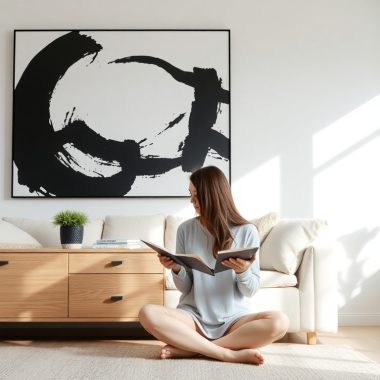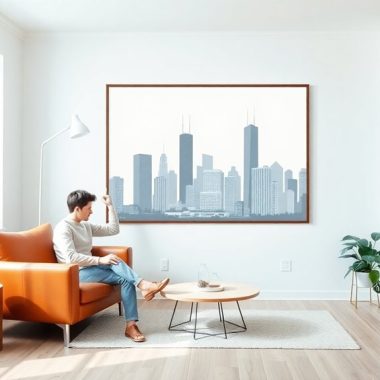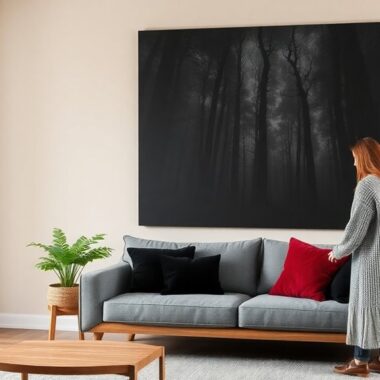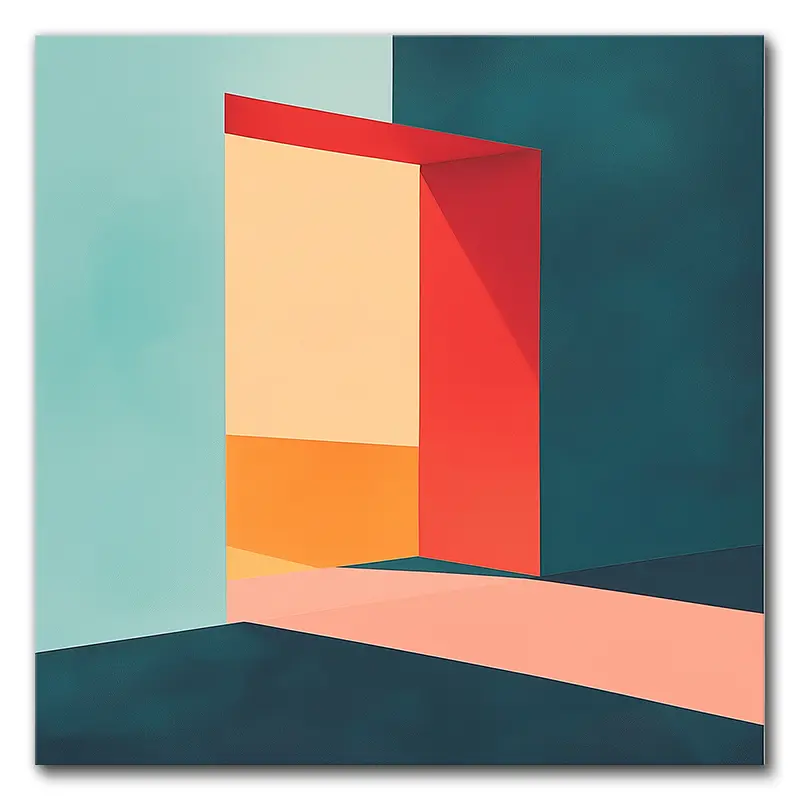To hang large canvas art affordably, you'll want to start by choosing the right size; ideally, it should occupy 60-75% of your wall space, creating a fascinating focal point. Gather materials like pine wood for framing, a staple gun, eye hooks, and perhaps Command strips for a no-damage solution. Mark the wall at eye level and use a level to keep things straight—nobody enjoys a crooked masterpiece! For best display, consider a salon-style arrangement if you have multiple pieces. Regular maintenance, such as dusting and protecting from sunlight, guarantees your art continues to shine, inviting viewers to admire it frequently. Discovering more about these tips will spark your creative instincts!
Choosing the Right Canvas Size

When it comes to choosing the right canvas size for your space, it's important to contemplate both the dimensions of your wall and the overall design of the room. You want to guarantee that the wall decor artwork you select doesn't just fit but also enhances the ambiance.
A common choice for large canvas art is 24×36 inches, which works well in many settings. However, if you're feeling bold and your wall has the space, sizes like 36×48 inches or even 4×3 feet can create a striking focal point that commands attention.
Aim for 60-75% of wall space when selecting your art size to achieve a harmonious look.
When you hang canvas art, proportionality is key; aim for your canvas to occupy about 60-75% of the width of the furniture it hangs above. This guideline keeps your space visually balanced, preventing your art from appearing lost or overwhelming.
In smaller rooms, consider opting for a single, larger canvas, as this can give the illusion of a more expansive area, unlike a collage of smaller pieces that may clutter the view.
And don't forget about breathing room! Leaving 6-12 inches of wall space around your canvas is like giving it a personal bubble, helping to avoid that cramped feeling that can sometimes accompany an overzealous decorating approach.
Materials You'll Need

To create your own large canvas art, you'll need a few essential materials that won't break the bank. First on your shopping list is pine wood, specifically 1×1 inch pieces for the frame; you can usually snag this for around $30, which is a steal considering the sturdiness it offers.
Additionally, working with a variety of textures can enhance your artwork, so consider adding exploration of textures to your creative process. Next, grab a canvas drop cloth measuring 6×9 feet—this choice isn't just economical but provides ample space for your artistic endeavors.
Now, let's talk about fastening that canvas to your frame. A staple gun is crucial for this task, helping you attach the canvas firmly. You'll also want some brad nails and wood glue, which work together to guarantee your frame stands the test of time—because, let's face it, we want our art to be as resilient as our enthusiasm for DIY projects!
To achieve a polished finish, wood filler is your best friend for covering up any nail holes, giving your piece a professional look. For hanging purposes, eye hooks and twine will serve as a straightforward and effective solution, allowing your masterpiece to grace your wall without much fuss.
If you're looking for a damage-free option, consider using Command strips to secure the canvas flush against the wall once your project is complete, making sure it stays put without leaving any marks.
With these materials in hand, you're well on your way to creating something beautiful. Happy crafting!
Step-by-Step Hanging Process

With your canvas art ready to display, the next step is hanging it properly for maximum impact. First, you'll want to determine the desired height, typically around eye level; mark the wall with a pencil for accurate placement. You know, there's nothing worse than a painting hanging too high—unless you're trying to give it a lofty vibe.
Next, grab a level to guarantee your masterpiece hangs straight, and mark both the top and bottom edges of the canvas on the wall. For larger canvases, consider using two picture hooks spaced evenly, as this will help distribute weight and prevent any unfortunate sagging that might make it look like your art is frowning.
If your canvas has a wooden frame, use a tape measure to find its center and mark it on the back so you can align it perfectly with your wall markings. Finally, secure your canvas to the wall using the designated hardware, making sure it's firmly in place. Before you step back to admire your handiwork, double-check that everything aligns correctly and looks fabulous.
Here's a handy table to guide you through the hanging process:
| Step | Action | Notes |
|---|---|---|
| 1 | Mark height | Eye level is key! |
| 2 | Use a level | Straight is the goal! |
| 3 | Choose hooks | Two for larger canvases! |
| 4 | Find center | Align with wall marks! |
| 5 | Secure & assess | Step back and enjoy! |
Now you're ready to showcase your art!
Tips for Displaying Multiple Pieces

Creating a stunning display of multiple canvas pieces can transform your space into a gallery-like atmosphere. To achieve this, you'll want to contemplate a consistent color palette or theme that unifies the arrangement, making it feel intentional rather than haphazard. A grid or salon-style layout works wonders; just make sure you maintain uniform spacing between frames—typically between 2 to 4 inches—to create visual harmony that delights the eye.
Additionally, hanging artwork at eye level (57-60 inches from the floor) can greatly enhance engagement and make the arrangement more enthralling, guaranteeing that each piece is appreciated fully proper placement strategies.
Before you start hammering away, grab some painter's tape to outline your planned arrangement on the wall. This clever trick allows you to visualize the spacing and layout without committing to permanent holes, saving you from a future game of patch-and-paint.
While it's tempting to cluster similar sizes together, incorporating a mix of different sizes and orientations adds a layer of visual interest; think of larger canvases as the anchors, balanced by smaller pieces that playfully dance around them.
For an effective focal point, place the largest canvas at eye level; it's like the VIP of your art display, guiding the viewer's gaze naturally to the surrounding pieces. This arrangement forms a flow that invites exploration.
Maintenance and Care for Canvas Art

Taking care of your canvas art is essential to guarantee it stays vibrant and beautiful for years to come. One of the simplest yet most effective ways to maintain its allure is by regularly dusting it with a soft, dry cloth. Think of it as giving your artwork a gentle spa treatment, preventing dirt and debris from settling in and dulling its brilliance over time.
It's also important to shield your canvas from the harsh embrace of direct sunlight, which can fade those lovely colors quicker than you can say "oops!" Aim to keep it in a well-lit, but indirect light setting.
If you happen to discover a stain—perhaps from an enthusiastic dinner party—don't panic. Just grab a damp cloth with a touch of mild soap and gently dab the affected area, ensuring you avoid soaking the canvas, as this could lead to warping.
Moreover, maintaining proper humidity levels in your home, ideally between 30-50%, is crucial to prevent mold growth, which is about as unwelcome as an uninvited guest.
Finally, take a moment every so often to inspect your canvas for signs of damage or sagging. If you notice any issues, don't hesitate to tighten or re-stretch it; after all, a well-supported canvas is a happy canvas.
With these simple tips, your canvas art can remain a stunning focal point in your home, capturing the curiosity and admiration of all who behold it.
Frequently Asked Questions
How Do You Hang Oversized Canvas Art?
To hang oversized canvas art, find wall studs for support, use heavy-duty hooks, and measure the height for eye-level placement. Verify it's straight with a level, and maintain consistent spacing for multiple pieces.
How to Hang a Large Canvas Without Nails?
To hang a large canvas without nails, use adhesive wall hooks or strips. Clean the wall, measure the height, and guarantee the canvas is lightweight to distribute weight evenly for a secure display.
Should a Large Canvas Art Be Framed?
Whether you should frame large canvas art depends on your style. Framing can enhance its look, but unframed pieces offer a minimalist feel. Consider your artwork's texture and your room's decor to make the best choice.
How to Hang Canvas Art Without Frame DIY?
To hang canvas art without a frame, attach D-ring hangers securely to the back. Use heavy-duty strips or wall anchors for support, and position it around 57 to 60 inches from the floor for best viewing.
Final Thoughts
In the grand fabric of home decor, hanging large canvas art can transform a mundane wall into a stunning focal point. With the right size, materials, and techniques, you're not just displaying art; you're inviting creativity into your space. Don't shy away from experimenting with multiple pieces, as they can create a visual symphony that captivates the eye. So, grab your tools, release your inner artist, and enhance your surroundings—because a well-hung canvas is worth a thousand words!
For those seeking the perfect canvas prints to elevate their decor, look no further than VerVeLush. Our expertise in art and unique offerings ensure that you'll find pieces that resonate with your personal style, making your walls truly come alive. Discover how our curated collection can help you create a stunning visual experience in your home.














